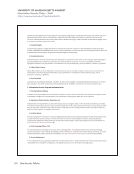39 SPEC Kit 360: Learning Analytics wide effort to improve the experience of students by refining administrative procedures and updating/ streamlining the student experience across the university. Yes, just started partnering with the Division of Academic & Student Affairs to share data around student use of space and services in a new Academic Success Center in the Libraries, and to share expertise and potential methodologies for investigating the impacts of library use. Additional comments N=3 Again, while we do not currently partner in this way, we plan to in the near future. No, except with OIPR, from whom we get aggregated student data. When we did an Assessment in Action project (before my time), I think we partnered with someone from IT Services, Teaching and Learning, and also from the Neighborhood Student Success Initiative. ADDITIONAL COMMENTS 43. Please enter any additional information regarding learning analytics activities at your library that may assist the authors in accurately analyzing the results of this survey. N=14 Because the university is in its infancy with learning analytics, so are the University Libraries. Beyond some stats collected in regards to instruction/workshop/research consultation attendance, we don’t collect much data in this arena. The university analyzes student portfolios and writing samples, but this data is rarely shared with the libraries, and we are not connected to it in any way. The librarians do informal assessments, but nothing robust enough to categorize as a “learning analytics initiative”. Current learning analytics work is tied to the First Year Studies program and a few other required courses with a major library component. Past projects have been more all-inclusive, and future work will likely be expansive. Generally speaking, the Libraries collects data for improving the Libraries (collections, services, and spaces). We are not currently correlating library data with student outcomes, but we have plans to do so in conjunction with the university. This effort is currently in the planning phase. I think it is fair to say the library is in the very beginning stages of considering how to engage in learning analytics. We are very interested in the results of this survey, and of learning more about how to move along the path. “Learning analytics” efforts still nascent at the university, but foundations are being laid. At this stage, efforts are not coordinated across campus units but there are beginnings. The Libraries are beginning by analyzing usage trends by types and patron groups across academic units to inform resource allocation and outreach activities. Most of the questions do not apply to our library and have been left blank. We have supplied responses to what seem relevant. My library is trying to catch up on collecting appropriate data for analysis. We’re ahead in some areas (journal use, circulation, etc.) but behind in others (assessment of learning outcomes). We tend to rely on our data collection tools to do the storage and management for us (we use LibInsight, which is a relatively newly acquired tool. Before that we were using spreadsheets stored in Sharepoint). It’s difficult to get buy-in from librarians and staff members to report. We can only work with the data we have. I also find that the privacy concerns beyond FERPA no longer serve us well as a library. How are we supposed to show that students who have multiple contact points with the library across their undergraduate time do have improved retention, graduation rates, GPAs, etc., if we cannot link those































































































































































